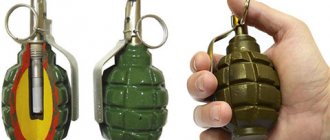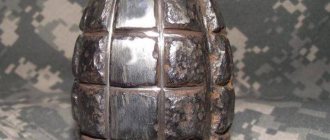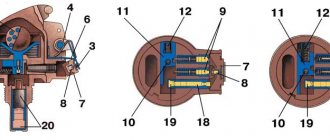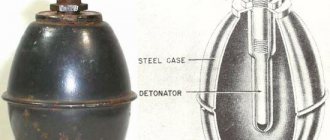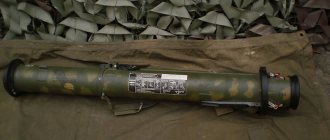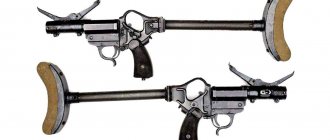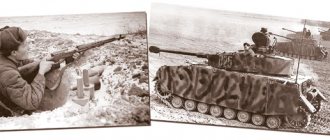The success that accompanied the use of hand grenades during the First World War gave impetus to their mass production. Almost all the armies of the world categorically adopted hand grenades into service, significantly increasing the firepower of the infantryman at one point. Infantry armed with hand grenades could solve many more problems on the battlefield. This was facilitated by the emergence of various types of these weapons. To enhance attack operations, high-explosive ammunition was used, where the main damaging factors were fire damage and shock wave. For defensive operations, fragmentation grenades were best suited. Such hand-fired ammunition includes the F-1 hand-held fragmentation grenade, which is familiar to the average person, popularly nicknamed the “lemon”.
Grenade f-1
This weapon can rightfully be called legendary. Armed with this type of grenade, Soviet soldiers fought in the Finnish war throughout the Great Patriotic War. At the same time, the strength and power of this ammunition, in addition to Soviet soldiers, was also appreciated by German soldiers. Even after the war, the Soviet Army for a long time was armed with F-1 hand fragmentation grenades, which became popular in the armies of other countries.
How did the legendary “lemon” appear?
The military was immediately able to appreciate the advantages that hand grenades had. Used as hand-fired anti-personnel ammunition, grenades radically changed close combat tactics. The shrapnel, which is the main destructive element of these munitions, could instantly incapacitate a large group of people. This detail was very convenient for conducting defensive actions when it was urgently necessary to stop an enemy attack. In the Soviet Union, such ammunition was taken very seriously. The reserves of hand grenades, inherited by the Red Army from the tsarist army, were exhausted during the Civil War. The infantry units of the Red Army were in dire need of increasing the combat effectiveness of their fighters through hand-held fire weapons.
Frag grenades
Faced with a shortage of hand grenades during the suppression of the Basmachi movement in Central Asia, in the mid-20s, on instructions from the Revolutionary Military Council, Soviet gunsmiths began developing new types of hand grenades. Two options for ammunition were considered at once - for offensive purposes and for defense. Already in 1926, the designer Dyakonov presented his development, a hand-held defensive-offensive grenade, to the high military commission. The finished sample received the index RGD-33 and was adopted by the Red Army. The defensive option was handled differently. Soviet designers did not reinvent the wheel. The French F-1 fragmentation hand grenade of the 1915 model was taken as the basis. It was this ammunition that the commanders and Red Army soldiers who had gone through the crucible of the fronts of the First World War and the Civil War were very familiar with.
Soviet gunsmith engineers, under the leadership of military engineer Khrameev, had to carry out an almost complete modernization of the ammunition. The original model was released in 1939 and was called and received the index F-1. The design of the F 1 fragmentation hand grenade differed from the French-made product. The main emphasis was placed on the perfection of the fuse, which the French grenade had a shock action. Such a mechanism for putting into action in modern conditions has become extremely dangerous and not always convenient. Not always during a fight does a fighter have the opportunity to make a throw. The grenade designers were faced with the task of creating a controlled fuse. The grenade must be activated after a certain time without mechanical contact of the body with an obstacle. A way out of the situation was suggested by engineer Koveshnikov, who managed to create a simple and reliable fuse.
Fuse
The grenade was intended to destroy manpower. The main damaging element was body fragments that were formed during the explosion of the explosive charge. For this purpose, the designers created a cast iron body, artificially divided into ribs. The ammunition was activated using manual manipulation. The Koveshnikov fuse provided the remote action of the F-1 grenade. In other words, the detonation of the ammunition charge occurred with a time delay of 5-6 seconds. The lemon exploded regardless of whether it was thrown at the target or continued to be in the hands of the fighter. A distinctive feature of a defensive-type hand-held fragmentation grenade was that the fragments scattered over a distance exceeding the throwing range, so such a weapon required special knowledge and skills during combat use.
Hand grenades RGD-33 and RG-42 photo
Hand grenades RGD-33 and RG-42 photo . During the Great Patriotic War, there was no type of ground combat in which “pocket artillery, and the most accurate one at that,” as hand grenades were called, were not used. Among the most popular in the Red Army were fragmentation weapons RGD-33 and RG-42 . In 1926, the Artillery Committee of the Artillery Directorate of the Red Army announced requirements for new offensive and defensive hand grenades. In 1929, prototypes of several designers were tested. Based on their results, it was decided to modify the sample proposed by M. G. Dyakonov, and as a temporary measure to modernize the then most popular hand grenade mod. 1914 (“bottles”), which was done in 1930. The Dykonov grenade was adopted for service only in 1933 under the designation RGD-33 (“Dyakonov hand grenade model 1933”). Being a completely new design, RGD-33 retained a number of features of the mod. 1914 - impact mechanism in the handle, a separate fuse inserted immediately before throwing, a sliding fuse, semi-finished fragments, a removable fragmentation cover that makes the grenade offensive-defensive.
RGD-33 defensive-offensive hand grenade Dyakonov model 1933
Inside the soldered cylindrical tin body of the RGD-33, between the bursting charge and the body, a tin tape with a square notch rolled up in three or four layers is laid, which, together with the body, produces up to 2000 light fragments during an explosion. In the defensive version, a cover (shirt) with an external notch was put on the body, producing about 200 heavy fragments with a large damage radius. The protection system is two-stage. In preparation for a throw, the fighter, pulling back the outer tube of the handle, cocked the striking mechanism, then inserted the fuse through the hole at the top of the body, and before throwing, moved the safety slide. An ingenious feature was the need for a sharp throw of the RGD-33 - then the outer tube of the handle moved away from the body and, already in flight, was turned by the mainspring so that the striker was able to pierce the primer of the fuse.
Offensive defensive grenade RGD-33 in section
RGD-33 was somewhat lighter than the grenade mod. 1914/1930, more technologically advanced in production, but the process of cocking and loading required a lot of time and attention, which is extremely difficult to withstand in close combat conditions. This was clearly demonstrated by the experience of the Soviet-Finnish war. On the eve of the Great Patriotic War, the RG-41 offensive grenade of the N.P. Belyakov system entered service, but it could not quickly replace the RGD-33 in production and in the army. Hand grenades RGD-33 and RG-42 photo , the most popular during the Great Patriotic War. A number of factories of the People's Commissariat of Ammunition, which was responsible for the production of grenades, were evacuated at the beginning of the war and only set up production in a new location (such as plant No. 479, evacuated from Moscow to Biysk). At the same time, the simplicity of the design and relatively large tolerances made it possible to organize the production of grenade parts at local and cooperative industry enterprises, in railway and mechanical workshops. Civilian factories were also transferred to the production of fuses - for example, the Vladimir Gramophone Factory and the Moscow Prosthetic Factory. Equipment with explosives was carried out at specialized factories of the People's Commissariat of Ammunition. In besieged Leningrad, surrogate explosives were used for equipment (for example, a mixture of ammonium nitrate with sawdust), and the body materials were changed. Here, in Leningrad, A. N. Selyankin, based on the RGD-33, created, with the participation of M. G. Dyakonov, a high-explosive anti-tank grenade with an explosive charge increased to 1 kg (Dyakonov died in Leningrad in December 1941).
- For the entire 1941, 3,150,000 hand grenades were fired in Leningrad.
- In besieged Sevastopol, over the last five months of defense, over 500,000 hand grenades , also resorting to improvisations - for example, in RGD-33, calibrated wire was replaced with waste steel cable, tinning of parts with galvanizing, soldering with welding.
RGD-33 hand grenade with separated handle and fragmentation jacket
On the other hand, the plant named after Leningrad was evacuated from Leningrad. Kalinin, where the RGD-33 was at one time being finalized, created on its basis a new grenade with a removable cover, which was put into service in 1943 under the designation ROG-43, and a change in the fuse simplified its handling.
Photo of scout N. Romanov, four RGD-33 offensive-defensive hand grenades in her belt, she is wearing a shirt with additional fragments (defensive version)
“Old-Servant” RG-42 Designs were required that were maximally adapted to mass production at non-specialized enterprises. And, perhaps, the most successful was the offensive RG-42, developed by S. G. Korshunov at GSKB-30 (the “old lady” F-1 became the main defensive grenade).
Hand grenades RG-42 RGD-33 and ROG-43 tactical and technical characteristics
Initially, the RG-42 was a housing from the RGD-33, adapted for installation on the thread of a universal remote igniter UZRG. Later, the design changed along with the manufacturing technology.
Schematic diagram of the RG-42 hand grenade
A steel strip rolled into three or four layers, cut into squares, was inserted into a solid cylindrical tin body with a tube for the fuse, and an explosive charge was placed.
Fragmentation hand grenades F-1 and RG-42 photo
During the explosion, the tape formed light fragments and contributed to more correct crushing of the body. The UZRG fuse, developed in 1941 by E. M. Viceni and A. A. Bednyakov, consisted of a striking mechanism with a safety lever and a pin and the fuse itself. In the operations of the Great Patriotic War, hand grenades were used in the millions. In addition to defeating and suppressing manpower, they were used to fight tanks and for mining. Mass production of the RG-42 continued after the Great Patriotic War and allowed it to remain in service with the Soviet army for several more decades.
Characteristics of fragmentation hand grenade F 1
The invention of Soviet designers had the same characteristic oval-shaped body, made of steel cast iron, which is more hard and produces a huge number of fragments when broken. The body has special fins, thanks to which the fragments formed during the explosion have a certain size and weight. When loaded, the F 1 grenade weighed 600 grams. The main charge of the ammunition was represented by TNT weighing 60 g. This amount of explosive was enough to ensure the rupture of the cast iron body. The fragments formed at the moment of the explosion scattered at a speed of 500-700 m/s, flying away from the epicenter of the explosion to a distance of up to 200 meters. On average, when an F-1 combat grenade exploded, the number of fragments reached 300 pieces, among which the number of lethal fragments was 30-40%.
Shards
The combat grenade had the following device:
- frame;
- explosive charge;
- trigger mechanism (fuse).
The F 1 grenade in combat version was green in color. The training version of the lemon was specially painted black, having two intersecting vertical and horizontal stripes on the body. The fuse of the combat grenade had no color. The training ammunition had a ring and a scarlet pressure lever.
The fuse is screwed into the upper part of the housing. Ammunition and fuses were located separately during transportation and storage. The hole for the fuse in the body was closed with a screw-in plug - a plug.
Grenade without a pin
Subsequent modernization
The F-1 fragmentation grenade had its first baptism of fire during the Soviet-Finnish War of 1939-40. The Red Army soldiers received a very convenient melee weapon. However, during the fighting, two serious shortcomings of the lemon were revealed:
- firstly, Soviet soldiers in most cases had no idea how a fragmentation grenade worked and did not always use it for its intended purpose. This naturally led to frequent accidents when the soldier throwing the grenade himself received mortal wounds and injuries;
- secondly, the remote fuse set the ammunition into action only after 6 seconds. Such a time delay was unacceptable in modern combat conditions.
Having assessed the results of the combat use of hand grenades, it was decided to improve the fuse, ultimately making a more reliable trigger mechanism of a universal type. Engineers Viceni and Bednyakov managed to create a simple and reliable fuse in the shortest possible time, which received the complex abbreviation UZRGM - unified manual grants modernized fuse. Due to its versatility, this fuse has become common since 1942 for all hand grenades in service with the Red Army. Now the time to detonate the main ammunition charge was 3-4 seconds. This type of fuse was subsequently modernized again, receiving the designation UZRGM-2.
UZRGM
Fundamentally, the device did not bring anything new. As in the previous modification, the main parts of the fuse were:
- hammer tube;
- impact mechanism;
- connecting part - bushing;
- guide washer;
- safety lever;
- check.
It was the pipe that was the main element, on the basis of which all other parts of the fuse were already mounted. The main action performed by the assembled mechanism was the ignition of the primer, after which further detonation of the main grenade charge occurred.
Using a connecting sleeve, the fuse was connected to the lemon body. It should be noted that in combat condition the firing pin of the UZRGM is cocked, held in this position by the trigger lever. The movement of the firing pin is ensured by a mainspring, which is held in tension by a safety or trigger lever. As a result of manual manipulation, the grenade, even with the pin pulled out, remains inactive. Only at the moment of throwing, when there is no pressure on the trigger lever, does the firing pin begin to move in the direction of the igniter. This element slows down the ignition reaction of the main detonator capsule. Only after this the main explosive charge of the ammunition is detonated.
Device
F 1 grenades were stored in storage areas in wooden boxes, 20 pcs. in everyone. The fuses for the lemons, like other hand grenades, were stored there. Each wooden box contained two sealed metal containers with UZRGM fuses. The total weight of the grenade box was 20 kg. Even during storage, the fuse is cocked. To put a grenade into combat condition, it is enough to unscrew the plug from the ammunition body and screw in the fuse in its place.
Grenades
This section contains materials about hand grenades, both modern and those that were in service with various armies of the world in the past. Here you can find general information about combat grenades, the history of their creation, the tactical and technical characteristics of these weapons, as well as a description of their combat use.
A hand grenade is an explosive type ammunition designed to be thrown by hand. Grenades can destroy enemy personnel and military equipment; this type of ammunition is often used to undermine enemy fortifications.
Hand grenades have a very rich history. Small projectiles designed for hand throwing have been known since ancient times. In those ancient times, clay pots filled with some kind of flammable mixture were usually used for throwing. Similar grenades were used in storming cities and naval battles. In the 15th century, the first metal grenades filled with gunpowder appeared. The first hand grenades were imperfect; they were ignited by a fuse and often exploded before or after the required moment.
In the 17th century, hand grenades began to be used during land battles. These shells were thrown by soldiers who had great physical strength; they were called “grenadiers.”
In the 18th century, grenades were removed from service almost everywhere; they were used only during sieges or during positional battles, which happened quite rarely. This was the case until the outbreak of the First World War, which became a real “finest hour” for this type of ammunition.
Hand grenades proved to be an ideal weapon for trench warfare. In 1909, the Rdultovsky grenade appeared, with which the Russian army fought through the First World War. The Germans very quickly realized the advantages of the new weapon and created the Stielhandgranate, the famous “mallet”, which served with the German army in two world wars.
After the first armored vehicles appeared on the battlefield, special anti-tank grenades were created, some of them even received a cumulative warhead.
Grenades were actively used in all conflicts of the last century and are currently in service with almost all armies of the world. This section contains materials about the most famous hand grenades of the past.
With the advent of grenade launchers and anti-tank missile systems on the battlefield, the importance of anti-tank grenades has decreased significantly, but hand grenades are the usual weapon of the infantryman and are very effective in close combat. Grenades are also in service with the Russian army. Russian grenades are a wide range of ammunition that can be used in both offensive and defensive combat. In this section you can find information about modern ammunition of this type, which is in service with the Russian army and special units.
By its design, a grenade consists of a fuse of various operating principles, a body, which during the explosion turns into fragments and an explosive. Sometimes ready-made destructive elements such as shrapnel are introduced into the grenade body. A well-trained soldier can throw a modern hand grenade forty or fifty meters.
Offensive grenades have a relatively small radius of fragmentation and can be used by a soldier on the offensive. Defensive grenades have a significantly larger damage radius and are designed to be thrown from cover.
There are also special types of grenades: gas, lighting, signal, smoke.


